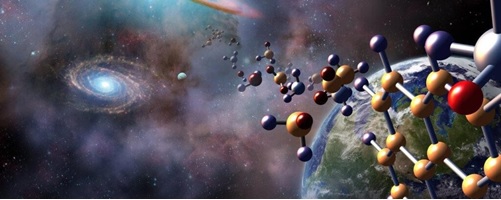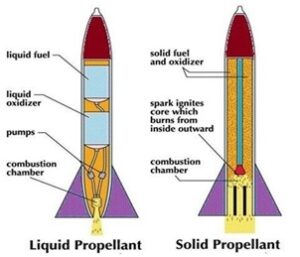Home » CHEMISTRY IN SPACE TECHNOLOGY

Chemical systems are essential for many launch vehicle applications, including those involving propellants, polymers, chemicals, materials, energy storage systems, and analytical characterisation. The primary areas where chemical systems are necessary are listed below.
The main bulk of a rocket’s response is composed of chemical propellants. They are essential for overcoming Earth’s gravity and launching the rocket into space. The third law of motion of Newton serves as the basis for how the rocket operates. Fuel and oxidizer are combined together (or in a single molecule) to form propellants, which, when ignited, go through simultaneous oxidation and reduction (combustion and burning) to release energy. A rocket engine produces thrust by ejecting mass flow at the maximum possible velocity after burning. Solid, liquid, and hybrid propellants are the three main categories utilized in rocketry.

In order to produce polymers and ceramics for use in space applications, materials sciences are essential. In the demanding circumstances of space, polymers and ceramics have certain qualities and capacities that are advantageous.
Electrical energy is very necessary to run every piece of machinery on launch vehicles and carry out the objectives of all space missions. The quantity of energy frequently determines how long a mission will last under difficult operating conditions. To maintain a constant supply of power, rechargeable energy storage systems with redundant units are used.
The main source of power for aircraft is electrochemical energy storage, such as fuel cells, super capacitors, and rechargeable batteries. These systems are necessary to power launch vehicle and spacecraft instruments and on-board systems, pyro ignition, navigation and guiding systems (actuators), telemetry and tracking, and other systems.

By analyzing and evaluating chemicals and materials for launch vehicle structures, propellants, pyrotechnics, adhesives, thermal protection systems, energy systems, etc., chemical characterisation plays a crucial role in space research.
A life-support system in human spaceflight is a collection of equipment that enables a person to survive in space. The standard life-support system’s responsibilities include: monitoring the environment; managing the atmosphere; and managing water and waste. The life-support system’s components are life-critical and were created using safety engineering standards.
Although prebiotic chemistry does not seem to have existed for very long in the Earth’s history—possibly about 500 million years—all the chemicals needed for metabolism, the spread of information in an early gene, and the self-assembly of a protocell’s membrane must have been made accessible during this period. Both endogenous and exogenous organic synthesis theories call for a chemical environment, which on a warm planet in a habitable zone would let chemical reactions to take place on surfaces in the liquid phase as well as the gas phase.
Dr. Swapnila Roy
HOD, SOBAS
August 16, 2023RECENT POSTS
CATEGORIES
TAGS
Agriculture Agriculture future AI Architecture artificial intelligence Bachelor of Commerce BA English BA Psychology BTech AIML BTech CSE BTech cybersecurity BTech Engineering Business management career Career-Specific Education career guide career option career scope Civil engineering commerce and management Computer Science Computer science engineering Data science degree education Engineering Engineering students English Literature english program Fashion Design Fashion design course Higher Education Journalism journalism and mass communication law Law career Machine Learning mathematics MBA MBA specialization Mechanical Engineering Pharmacy Psychology Research and Development students
Nachauli, Jasana Road, Faridabad, Haryana
Address: C-72, Second Floor, Shivalik, Near Malviya Nagar,
Above HDFC Bank, New Delhi 110017
Landline No. - 011-46570515 / 45138169 / 41755703
Mobile No. - +91-7303152412 / +91-7303152420 / +91-9311321952
Toll Free: 1800-120-4613
Mobile : 8447744303 | 8447744304 | 8447744306 | 8447744309
8700003974 | 8700003411 | 8700003749
Copyrights © 1998 - 2025 Lingaya's Vidyapeeth (Deemed To Be University). All rights reserved.
LV only conducts physical/online verification of any document related to examination on the following email id:
It is important to note that the following email IDs and domains are fraudulent and do not belong to our university.